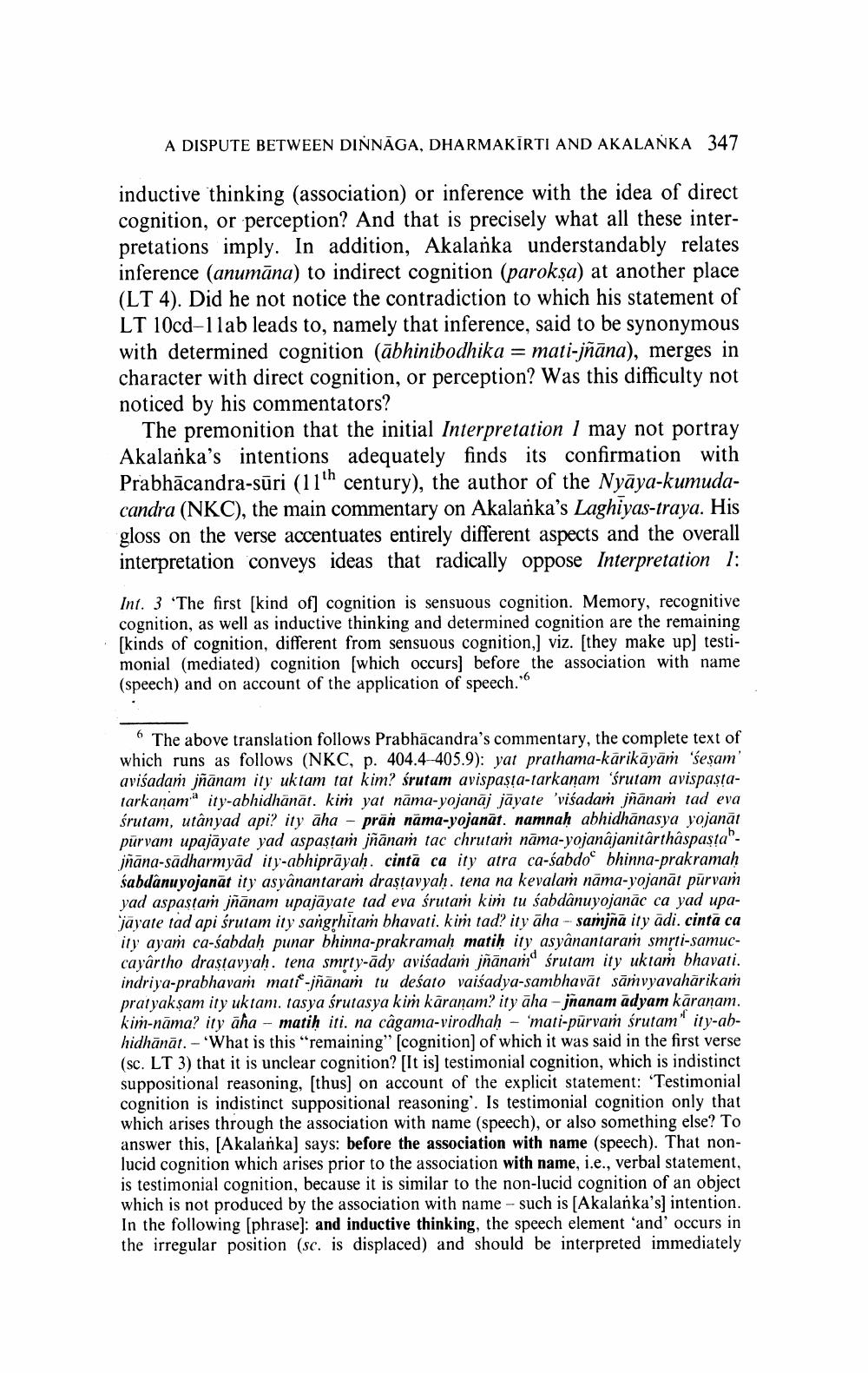Book Title: Pramanas And Language Dispute Between Dinnaga Dharmakirti And Akalanka Author(s): Piotr Balcerowicz Publisher: Piotr Balcerowicz View full book textPage 5
________________ A DISPUTE BETWEEN DINNĀGA, DHARMAKĪRTI AND AKALANKA 347 inductive thinking (association) or inference with the idea of direct cognition, or perception? And that is precisely what all these interpretations imply. In addition, Akalanka understandably relates inference (anumāna) to indirect cognition (parokşa) at another place (LT 4). Did he not notice the contradiction to which his statement of LT 10cd-11ab leads to, namely that inference, said to be synonymous with determined cognition (ābhinibodhika = mati-jñāna), merges in character with direct cognition, or perception? Was this difficulty not noticed by his commentators? The premonition that the initial Interpretation 1 may not portray Akalanka's intentions adequately finds its confirmation with Prabhācandra-sūri (11th century), the author of the Nyāya-kumudacandra (NKC), the main commentary on Akalanka's Laghiyas-traya. His gloss on the verse accentuates entirely different aspects and the overall interpretation conveys ideas that radically oppose Interpretation 1: Int. 3 'The first [kind of cognition is sensuous cognition. Memory, recognitive cognition, as well as inductive thinking and determined cognition are the remaining [kinds of cognition, different from sensuous cognition,) viz. [they make up] testimonial (mediated) cognition (which occurs before the association with name (speech) and on account of the application of speech." 6 The above translation follows Prabhācandra's commentary, the complete text of which runs as follows (NKC, p. 404.4-405.9): yat prathama-kārikāyām 'seșam' avisadam jñānam ity uktam tat kim? śrutam avispasta-tarkanam 'śrutam avispastatarkanam ity-abhidhänāt. kim yat nāma-yojanāj jāyate 'visada jñānam tad eva śrutam, utânyad api? ity āha - pran nama-yojanāt. namnah abhidhānasya yojanāt pūrvam upajāyate yad aspastam jñānam tac chrutam nāma-yojanâjanitàrthâspasta"jnana-sādharmyād ity-abhiprāyah. cintă ca ity atra ca-śabdo bhinna-prakramah sabdanuyojanät ity asyânantaram drastavyah. tena na kevalam nama-yojanāt pūrvam yad aspastam jñānam upajāyate tad eva śrutar kim tu sabdânuyojanāc ca yad upaJayate tad api śrutam ity sangrhitam bhavati. kim tad?ity āha - samjna ity ādi. cintă ca ity ayam ca-sabdaḥ punar bhinna-prakramah matih ity asyânantaram smrti-samuccayârtho drastavyah. tena smrty-ādy avisadam jñānamśrutam ity uktam bhavati. indriya-prabhavam mati-jnanam tu deśato vaisadya-sambhavāt sāṁvyavahārikam prat yakşam ity uktam, tasya śrutasya kim karanam? ity āha - jnanam adyam karanam. kim-nāma? ity āha - matih iti. na câgama-virodhaḥ - 'mati-pūrvam śrutam" ity-abhidhānāt. - 'What is this "remaining" (cognition of which it was said in the first verse (sc. LT 3) that it is unclear cognition? [It is) testimonial cognition, which is indistinct suppositional reasoning, (thus) on account of the explicit statement: "Testimonial cognition is indistinct suppositional reasoning'. Is testimonial cognition only that which arises through the association with name (speech), or also something else? To answer this, (Akalanka) says: before the association with name (speech). That nonlucid cognition which arises prior to the association with name, i.e., verbal statement, is testimonial cognition, because it is similar to the non-lucid cognition of an object which is not produced by the association with name - such is (Akalanka's) intention. In the following (phrase): and inductive thinking, the speech element and occurs in the irregular position (sc. is displaced) and should be interpreted immediatelyPage Navigation
1 ... 3 4 5 6 7 8 9 10 11 12 13 14 15 16 17 18 19 20 21 22 23 24 25 26 27 28 29 30 31 32 33 34 35 36 37 38 39 40 41 42 43 44 45 46 47 48 49 50 51 52 ... 58
